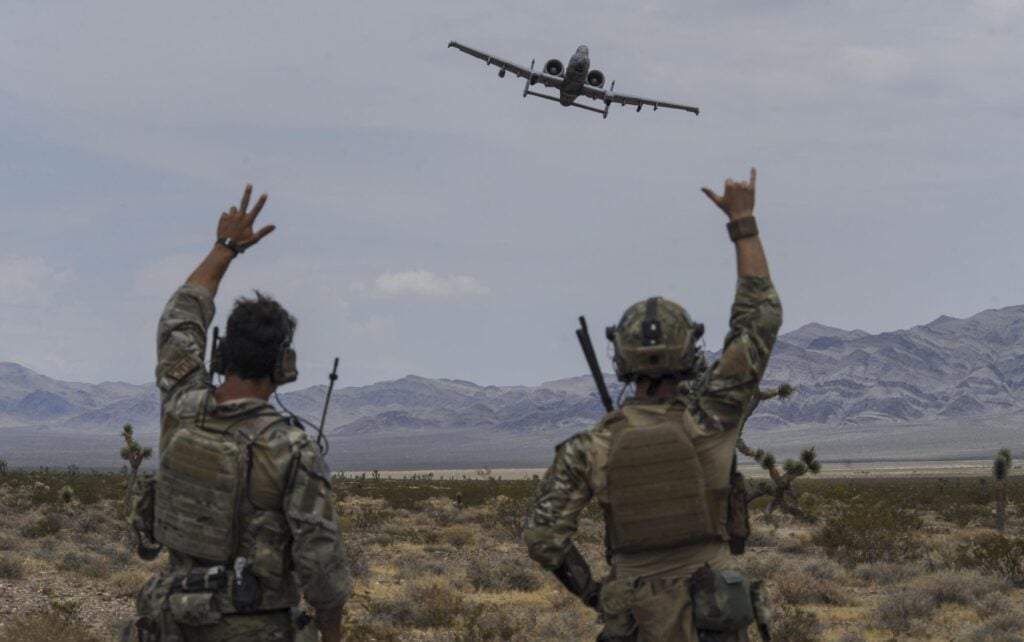Close Air Support Timeline Cut; Wait For Tech Was Too Long
Posted on

Air Force JTACs (Joint Terminal Attack Controllers) wave to an A-10 during training.
SOFIC: App-enabled handheld devices have slashed the time it takes for Air Force controllers on the ground to call in airstrikes; and the Pentagon, as well as other federal agencies like Homeland Security are buying into the technology in a big way.
Over the past several years, Army and Special Operations forces have been using the Android Tactical Assault Kit (ATAK) app in places like Iraq, Afghanistan, and Syria to give troops the ability to see more, communicate more easily with other units, and find out where potentially hostile forces are on the grid.
“We’ve taken the JTAC kill chain from minutes — that 16 step process — down to seconds. Close air support is now seconds of coordination,” Col. Joel Babbitt, head of the SOF Warrior Office, told defense industry reps here today.
In Syria, troops have been using the system to define the “forward line of troops,” pinpointing exactly where small US outposts are located, and how close they are to agreed-upon boundaries with Russian, Syrian, and Iranian-backed troops.
Those successes have led Special Operations Command to go all in on the tech, which was originally developed by DARPA and the Air Force Research Lab. “We are integrating everything into ATAK,” Col. Joel Babbitt, head of the SOF Warrior office, told defense industry reps here on Tuesday. “Let me be very clear: if you don’t speak ATAK you’re not talking to me.”
Babbitt told industry reps here that ATAK “has gone viral throughout the entire Department of Defense.” The Army is also going big on the technology, bringing about 160,000 users into the program over the next six months, while the Air Force is “bringing everything onto it,” and Navy F-18 pilots are using different versions.
In the aftermath of 2017’s Hurricane Harvey in Texas, DHS and the National Guard made use of ATAK, helping both coordinate search and rescue efforts.CAS
Mark Shook, the Joint Special Operations Command’s science and technology lead, applauded the command for eventually pushing the JTAC mission, but said it took military leadership too long to pay attention to the capability and get it into the field.
Several years ago while some were pushing for ATAK to be funded and fielded, “it was falling on deaf ears, because it didn’t quite fit exactly in somebody’s nice little picture of a program, and it wasn’t funded” within a traditional acquisition program, Shook said.
“We cannot afford to let the process say no to some of these game-changing capabilities,” he added.
That fight — trying to streamline cumbersome acquisition practices — is something that has been picked up by the Pentagon and its DIU and rapid acquisition efforts, but it is still very much a work in progress.
One Pentagon effort in particular, led by Principal Deputy Assistant Secretary of Defense for Acquisition Enablers Stacy Cummings, is trying to streamline the process.
Speaking Wednesday morning, Cummings said she wants to understand the “individual characteristic of programs,” and allow program managers to be able to tweak the system to modernize more quickly.
“The purpose of my office is really to be thinking about how we enable the services and how do we enable the [combatant commands], how do we enable the warfighters to get the capability that they need in support of the national defense strategy,” Cummings said.
“If we can create a more modular approach to the way that we buy capabilities, we can deliver them faster, we can get them in the hands of the user faster, we can test them faster and we can reuse them when it makes sense,” Cummings said.
Subscribe to our newsletter
Promotions, new products and sales. Directly to your inbox.
